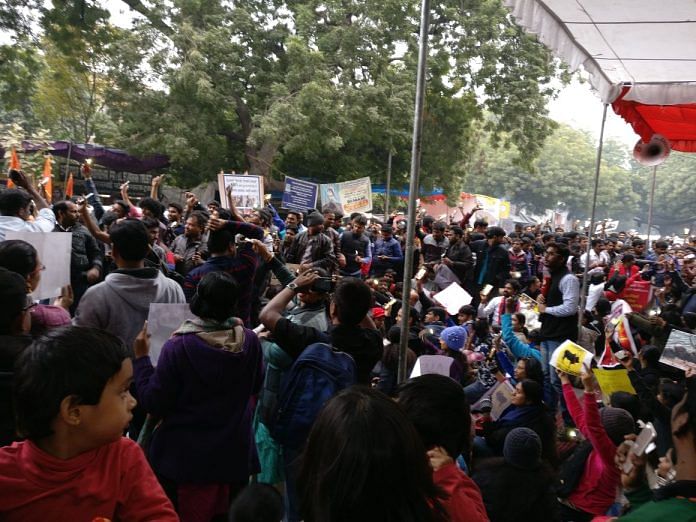A week after the Supreme Court upheld the right to protest, confusion over the order is keeping people from returning to agitation epicentre in earnest.
New Delhi: Protesters of different stripes are making their way back to Jantar Mantar, the epicentre of citizen agitations, a week after the Supreme Court upheld their right to protest. However, what was once a flood is now down to a trickle.
It was nine months ago that a plea filed by locals vexed with the constant noise and littering led the National Green Tribunal (NGT) to ban protests at Jantar Mantar. Before that, a protest or dharna dotted the area roughly every 10 feet, and chants about deprived rights lent the air a deep touch of angst. According to Delhi Police figures, the site hosted at least eight to 10 protests every day.
While the Supreme Court order was greeted with cheer, uncertainty about its exact terms has tempered the sentiment. Seeking to strike a balance between the rights of protesters as well as that of the petitioners, the court had asked the Delhi Police commissioner to set “proper guidelines” for “limited use” of the sites by protesters.
However, despite the confusion about what this will exactly entail, four- to five groups set up camp at Jantar Mantar days after the Supreme Court order.
One of them comprises members of the All India Progressive Dairy Farmers’ Association, who are agitating against falling milk prices and arrived at Jantar Mantar after similar protests in other states.
“This is the centre. This is where the decisions are made. We had to protest here,” Uday Tiwari, the association’s national coordinator, said.
Asked if they had gone over the prospect of ejection amid the uncertainty that followed the SC order, Resham Singh, a member, retorted, “If our livelihood itself is under threat, what other threat can possibly deter us?”
Across the street from them, women in bright saris cheer in unison every time the politician addressing them from a makeshift podium raises slogans of empowerment.
They are members of the All India Unorganised Workers Congress, who have gathered at Jantar Mantar to demand a law to ensure social security for women who work as domestic helps.
The women told ThePrint that, as part of their protest, they will also write postcards to Prime Minister Narendra Modi to push their case.
Also read: In judiciary-executive tussle, it’s now up to people to fight mob lynching
Prime Lutyens’ real estate
Jantar Mantar has emerged as the hub of protests in India on account of its proximity to the seat of power, and the fact that a day’s booking fees for the next best alternative, Ramlila Maidan, stood at Rs 50,000.
In the wake of the NGT ban last October, the fees was waived for a portion of the area at Ramlila Maidan by the north Delhi civic agency, but the site still failed to take Jantar Mantar’s place on account of the distance factor.
The NGT order followed a petition filed by seven residents of Jantar Mantar, a piece of prime Lutyens’ real estate three kilometers from the Parliament House, who claimed the daily commotion of protests had disrupted their lives.
One of them, Varun Seth, the owner of two cinema halls in Delhi, laid out the motivation behind their case in an interview with The Indian Express.
“They come in numbers, create havoc with slogans, walk around semi-nude, urinate on walls, and leave behind a mess… obviously I want them out of here,” he told the paper, adding that cars parked outside by one rank, one pension protesters once held them up during a family emergency.
In its order, the NGT had empathised with the residents. “It is amply clear that the petitioners are suffering because of gross violation of laws, air pollution and health hazards due to lack of cleanliness and non- performance of duty by the authorities,” the bench noted.
However, the order led a bunch of petitioners to seek respite from the Supreme Court, which ruled on 23 July that there could not be a blanket ban on protests at Jantar Mantar.
Residents were obviously less than pleased.
A security guard at one of the homes in the area said he was furious about the imminent return of the protesters. “They would block all the roads, it would be a real nuisance… It would take hours to take dadi to the hospital,” he recalled, referring to an elderly ailing resident.
But does he not empathise with those protesting? He doesn’t, he said. “If they are angry, they should just go to Modi’s door and protest. Not at our door,” he added.
Some, however, are ambivalent. “I have been here since 1984,” said a tea-seller near the protest site, “Protests or the lack of them make no difference to my life.”
Also read: Slept on road, sprawled out on L-G’s sofa: Many faces of Kejriwal’s protests



